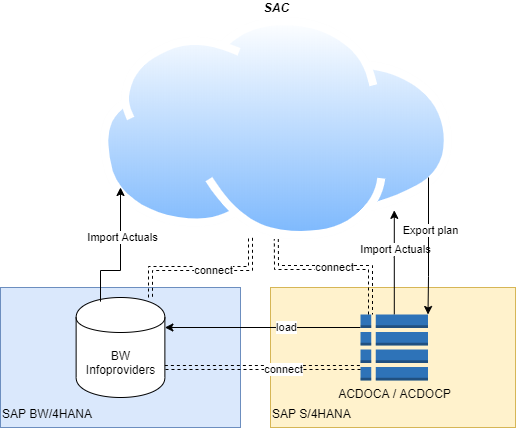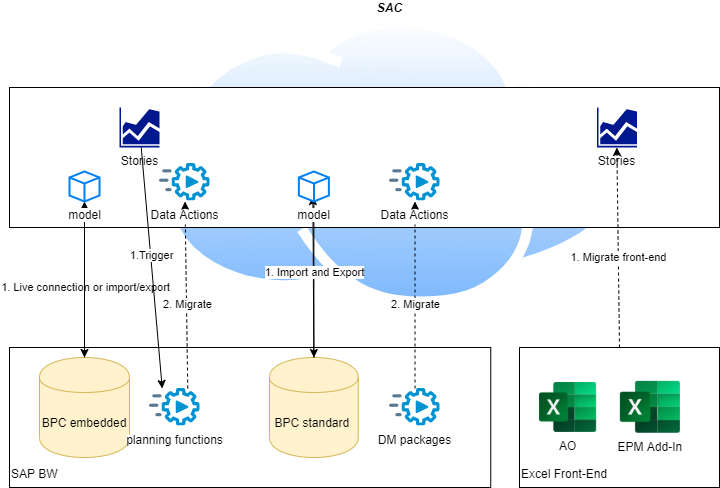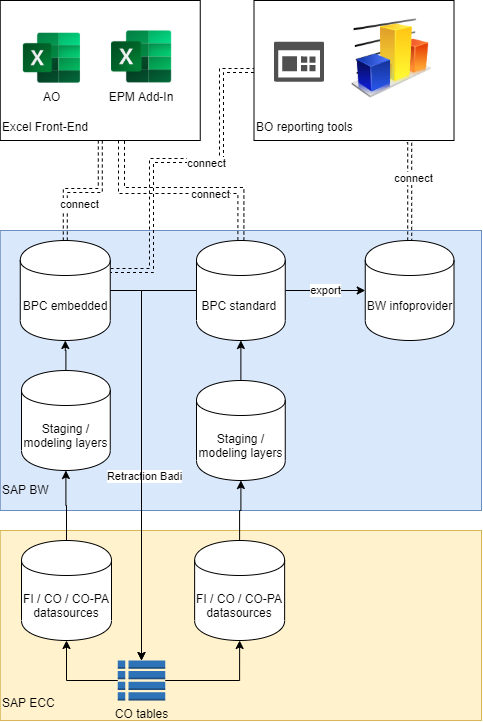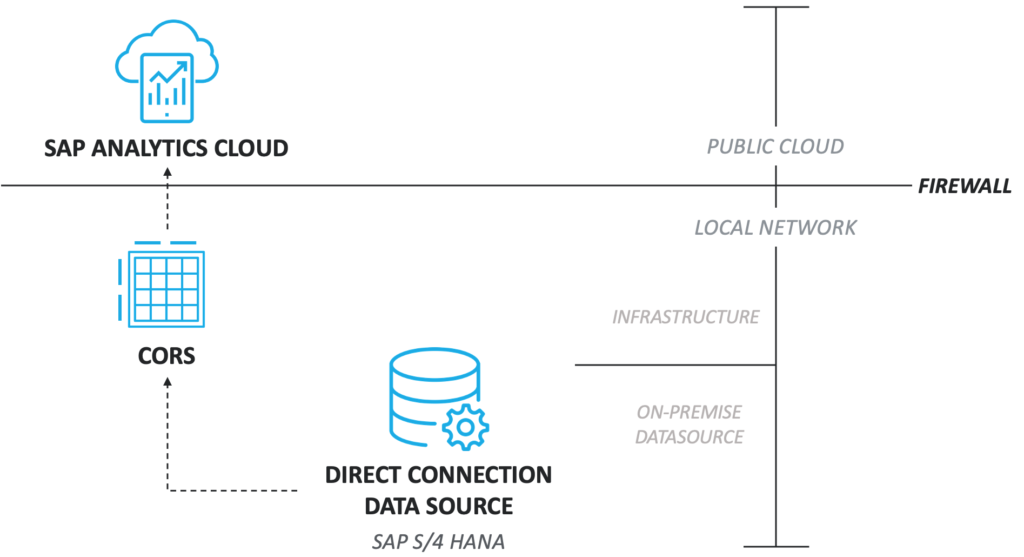When starting a project to automate forecasting and budgeting processes, one of the key topics is integration with a planning tool. In this article, our SAP Planning & Analytics architect will discuss the topics of data integration and security.
Data integration
To start your planning process, the first thing to do is to start with a set of actual data. At the same time, a process must be in place to update the actual data to create a new version of the forecast on an ongoing basis. The result of your planning process will be your final budget and forecast data.
On the other hand, your ERP system also needs this additional data to compare the actual with the forecast to leverage additional operational planning capabilities. In order to implement a fully integrated planning scenario, actual data must come from a variety of sources and applications.
In a traditional configuration, where data integration is managed by a data warehouse and SAP Business Planning & Consolidation (BPC) serves as a planning tool integrated with SAP Business Warehouse (BW), the actual data was loaded using the extract, transform and load (ETL) capabilities and also using data source concepts from SAP BW. The data source concept itself was already an advanced form of automatic integration at the time, as it provided standard tools that transformed the relational data schemas of SAP ECC into a flat data structure, suitable for loading into a data warehouse. This already reduced the complexity of setting up an ETL process to your data warehouse and therefore already integrated data into your planning solution. To send the final version of your plan back to SAP ECC, a rather complex "shrinkage" process had to be set up, which required very advanced knowledge of ABAP programming.
Due to the evolution of in-memory databases and Hyperscalers solutions, the integration architecture is greatly simplified with a solution like SAP Analytics Cloud for Planning (SAC). While the data warehouse served as an intermediary to create a flat data structure suitable for import into SAP BPC, a modern ERP system like S/4HANA works with a much more simplified data model suitable for direct integration into SAC. For example, when a customer purchases S/4HANA cloud, SAC already contains the business content definition (or structure?) for planning and exporting plan data to S/4.
Another important topic is the integration of your planning data into your reporting and analysis solutions. When using SAP BPC embedded, the integration was done in SAP BW. This is because BW provides so-called information providers or "infoproviders". These act as master data structures to store your planning data on which BEx (Business Explorer) queries are built to connect to various reporting tools. The BPC standard was not as easily integrated into SAP's portfolio of reporting solutions, since BW "infoproviders" were automatically generated with technical names and an MDX (Multidemensional Expressions) engine was used to generate reports on standard BPC data in the integrated Excel front-end tool, via the EPM add-in. Since other SAP reporting solutions no longer use this MDX engine, data had to be extracted from the BPC cubes to other BW infoproviders.
Since SAC is a solution that integrates three main pillars (analytics, planning and predictive), integration with analytics is delivered as a standard feature. Let's take a closer look at examples of on-premise and Hyperscale solution architectures:

In a scenario where SAC is used as a planning tool on your S/4HANA system, data can be imported directly from S/4HANA or displayed live in SAC. From a technical standpoint, it is not necessary to load your data into BW/4HANA in order to begin your planning process. However, in almost all scenarios, a data warehouse will be in place to integrate various external data sources and then perform complex transformations and calculations from that data. In this case, you can integrate your SAC planning models with BW information providers, importing the actual data required while exporting your planning data to S/4HANA.

In case your SAP ERP is not yet migrated to S/4, no standard export functionality exists. You will have to revert to the traditional configuration where you export your planning data to BPC or another BW information provider and repatriate it to SAP ECC. Even so, SAP provides the advantage of having tight integration with BPC, i.e., live connections and rewrites in BPC embedded, and import/export functionality for standard BPC.
As explained above, the scenario on how you integrate SAC planning into your environment will therefore largely depend on your current architectural configuration, but the good news is that SAP supports various options for import, export and live connections.

The Security
Some companies may be concerned about data privacy when connecting with SAC to direct sources. In fact, your direct data will never be transmitted to SAC servers. Your browser connects to SAC, SAC returns the metadata to the dashboard you are running, and then the browser performs a multiple origin resource sharing call (CORS - a technique needed to overcome the limitation in a web application to access resources from a different origin) to your local system to get the data. So the data only travels from your local system to your browser. Of course, your environment must be properly configured for this to be possible.
When your users are working in S/4HANA, and then move to the planning screens, you certainly want to provide a seamless experience for them, without them having to log into another system. To make this work seamlessly, SAP has provided several single sign-on (SSO) options with your S/4 or Netweaver systems.

In addition, SAC provides a Security Assertion Markup Language (SAML - an open standard for exchanging authentication and authorization data between parties) to enable SSO, simplifying not only authentication to SAP Analytics Cloud, but also to connected data sources in your environment. It is also possible to leverage your current authentication mechanism, such as Kerberos or client certificate authentication. To do this, simply choose the "none" authentication option in the SAC connection.
A final interesting point is the ability to assign different roles in SAC to control user access to different models. Using SAML for connectivity, it is possible to link SAML attributes of users to roles in SAC. In this way, users can be assigned SAC roles centrally from your on-premises system. Note that there is also the possibility to create users in SAC dynamically.
The choice between the various options will have to be analyzed in detail by the security managers through the different software and infrastructure environments.
Conclusion
We hope that we have been able to explain that integration is one of SAC's strengths. Various options exist to integrate your data from transactional solutions and data warehouses, even beyond the SAP software layer. This allows you to seamlessly integrate your planning process with your transactional system. Thanks to the various connection and authentication options that SAC provides, a high degree of integration and security can be achieved.
Micropole supports its clients in designing and aligning their data-driven strategy with the latest market innovations. We integrate multiple technologies (Machine Learning, AI, IOT) in a SAP-centric environment, allowing our clients to benefit from all the added value available & stay ahead of their industry.














